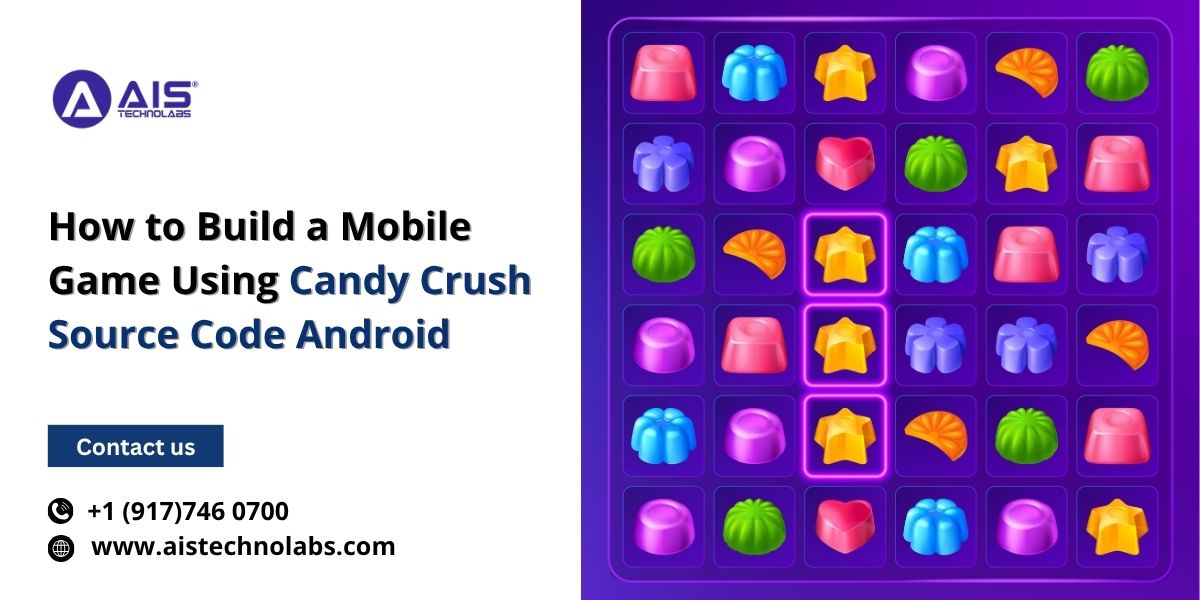If you’ve ever dreamt of creating a fun, addictive puzzle game like Candy Crush, the Candy Crush source code for Android can be your perfect starting point. Instead of building everything from scratch, you can leverage a pre-built codebase to speed up development, add your creative touch, and release your game faster.
In this guide, you’ll learn the steps to use Candy Crush source code effectively, customise it for your audience, and prepare your game for publishing on the Google Play Store.
1. Understand What Candy Crush Source Code Android Offers
Before you start, it’s important to know exactly what you’re working with. The Candy Crush source code for Android is typically a complete match-3 puzzle game engine. This means it already comes with:
- Core gameplay logic – matching, swapping, and scoring mechanics
- Level generation – either manual or algorithm-based level creation
- Graphics & UI – basic images, animations, and interface layouts
- Sound effects – background music and in-game sounds
- Basic monetisation hooks – ads or in-app purchases in some scripts
Understanding these features will help you plan your customisations and avoid unnecessary rework.
2. Choose a Reliable Source for Your Code
When working with game scripts, always get your code from a trusted provider. Poorly written or outdated code can lead to security risks, crashes, and poor performance on Android devices.
Look for:
- Well-documented code – with comments explaining each function
- Compatibility – updated to work with current Android SDK versions
- Licensing clarity – so you’re legally allowed to modify and publish
3. Set Up Your Development Environment
To work with the Candy Crush source code Android, you’ll need:
- Android Studio – Google’s official IDE for Android development
- Java or Kotlin knowledge – most Android games are written in these languages
- A device or emulator – to test your game as you develop
Once you’ve installed Android Studio, import the source code project into it. Make sure all dependencies are correctly configured and that the code compiles without errors.
4. Customise the Gameplay and Design
This is where your creativity comes in. Even though you’re starting with an existing script, you don’t want your game to be a clone of Candy Crush.
You can customise:
- Graphics – change backgrounds, tiles, and animations
- Sound effects – replace default sounds with your own audio files
- Levels – design unique puzzles to challenge players
- Themes – seasonal or event-based visuals to keep the game fresh
This step is crucial because it helps you create a unique brand identity while keeping the proven match-3 gameplay mechanics.
5. Add Engaging Features
To make your game stand out, consider adding extra features such as:
- Daily challenges – encourage players to return regularly
- Power-ups & boosters – help players overcome difficult levels
- Leaderboards – foster friendly competition among players
- Social sharing – allow players to share scores with friends
These elements increase player engagement and retention, giving your game a better chance of success.
6. Test Your Game Thoroughly
Before releasing your game, test it on multiple Android devices with different screen sizes and performance capabilities. Watch for:
- Crashes – fix bugs before players find them
- Performance issues – ensure smooth animations and quick response times
- User experience – make sure the interface is easy to navigate
Testing also includes playing through all levels to ensure there are no impossible puzzles or broken mechanics.
7. Monetise Your Game
Most Candy Crush-style games make money through ads, in-app purchases, or a mix of both. You can integrate:
- Banner and interstitial ads – through platforms like Google AdMob
- In-app purchases – for extra lives, boosters, or special levels
- Subscription models – for premium, ad-free experiences
Balancing monetisation with gameplay fairness is important. Too many ads or paywalls can drive players away.
8. Prepare for Publishing
Once your game is tested and ready, follow these steps to publish:
- Create a Google Play Developer Account
- Prepare game assets – icons, screenshots, and promotional images
- Write an engaging Play Store description – include relevant keywords like Candy Crush source code Android naturally
- Upload your APK or App Bundle to the Google Play Console
- Set pricing and availability
9. Promote Your Game
Publishing your game is just the beginning. Use these promotion tactics to attract players:
- Social media marketing – share gameplay videos and tips
- Press releases & blogs – get coverage on gaming websites
- Influencer collaborations – work with YouTubers or TikTokers who review games
- App Store Optimisation (ASO) – optimise your title, description, and tags for visibility
10. Maintain and Update
A successful mobile game is never truly “finished.” Regular updates keep players engaged and attract new ones.
Consider adding:
- Seasonal events – special limited-time challenges
- New levels – to keep long-term players interested
- Bug fixes – for a smoother experience
Conclusion
Building a mobile game with Candy Crush source code Android can save you time, reduce costs, and let you focus on creative enhancements. By customising the gameplay, testing thoroughly, and promoting effectively, you can create a fun puzzle game that keeps players coming back for more.
If you need professional assistance, AisTechnolabs offers expert guidance in game development. You can contact us to learn more about how to make your gaming project a success. Contact us
